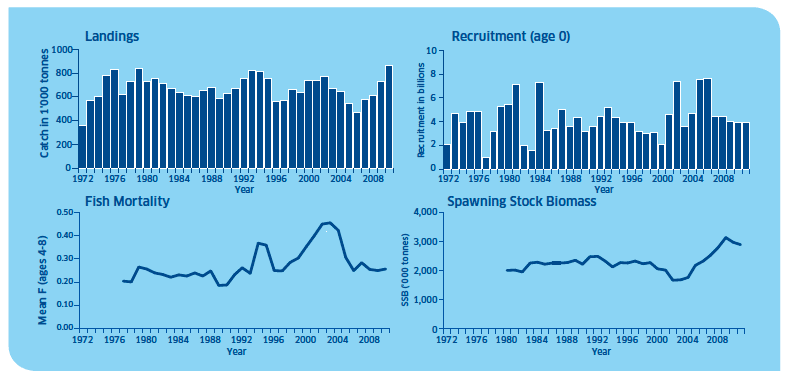Fish and Shellfish Stocks 2012
Fish and Shellfish Stocks 2012. State of Scottish fish stocks, TACs and biology of the stocks for 2012.
ASSESSING THE STATE OF FISH STOCKS
To carry out a stock assessment, it is necessary to build up a picture of how the fish populations change over time and examine the historical trends. The information required comes from market sampling, discard sampling and research vessel surveys. Attention is also given to information available from fishermen's surveys.
Market sampling
Throughout the year, landings at Scottish fish markets are sampled regularly by staff from MSS. Information on length and age are collected for a range of species along with details of the landings made by the fishing fleets.
The most common method used to age fish is to examine the ear stone (otolith) which is found in the head of the fish. These bony structures give an accurate picture of the life history of the individual fish. They consist of layers that are built up like the rings on a tree. Each year can be identified by a dark and light band corresponding to winter and summer growth. The age of the fish can be determined by counting the number of bands on the otolith. By counting the ages of a large number of fish, the age structure of the whole population can be estimated. This gives a good indication of how the stock is standing up to the effects of fishing. If there are not many young fish, then recruitment has been poor and this could mean problems for the future. If there are no old fish present in the stock, this could be an indicator of over-fishing. If the stock is in a healthy state, fish of a wide range of ages are present. Each year MSS staff take around 900 samples of landings across a range of 18 species. Over 305,000 fish are measured and around 24,000 are aged.
Observer sampling
Sampling the landings is very important, but it gives no information about those fish which are caught that never reach the market. Many of the fish and shellfish caught at sea are unwanted and thrown away for a variety of reasons, either to comply with the quota limits, because they have limited commercial value or because they are below the legal minimum landing size. With the co-operation of the fishing industry, MSS staff make around 100 trips per year, collecting information on the amount of fish discarded, as well as details of their length and age composition. Each year around 290,000 discarded fish and shellfish are measured and around 18,000 are aged. This information is then combined with the landings data to give a complete picture of the effects of fishing on the stocks.
Research vessel surveys
Research vessel surveys give information on the numbers of young fish 'recruits' which are too small to be caught and landed by commercial vessels. They also provide information on changes in the distribution and abundance of the adult stock. Bottom trawling surveys are used for cod, haddock and whiting, whereas acoustic surveys are used for herring. Shoals of herring show up on echo-sounders as 'marks'. Analysis of the strength of the echo-soundings gives an estimate of the total biomass. For mackerel, surveys are carried out to estimate the total number of eggs produced during the spawning season. This is used in combination with information on the numbers of eggs produced by female mackerel of different lengths to estimate the size of the population. Surveys employing underwater television techniques are used for estimating Nephrops abundance.
Summary
The Main Characteristics
By collecting information each year from the fish landings, observer trips and research vessel surveys, scientists build up a picture of how the stocks change over a long period of time.
Each year when they carry out stock assessments, scientists plot out the important characteristics of the population. They look at the trends over time and decide on the 'state of the stock'. They also try to predict what will happen to the stock in the future.
Trends in landings, recruitment, fishing mortality and spawning stock biomass, for an example fish stock for the period 1972 to 2010 are shown below. These can be used to answer questions such as:
- Are landings increasing or decreasing?
- Is recruitment high or low in recent years?
- Is spawning stock biomass as a high or low level?
- Is fishing mortality rising or falling?
This example shows that while the landings have remained fairly consistent over the time period, the rate of fishing mortality gradually increased over the same period, reaching a peak in 2004, before decreasing in recent years. This decrease corresponds with an increase in spawning stock biomass, which was boosted by several above average recruitments into the stock.

Contact
There is a problem
Thanks for your feedback